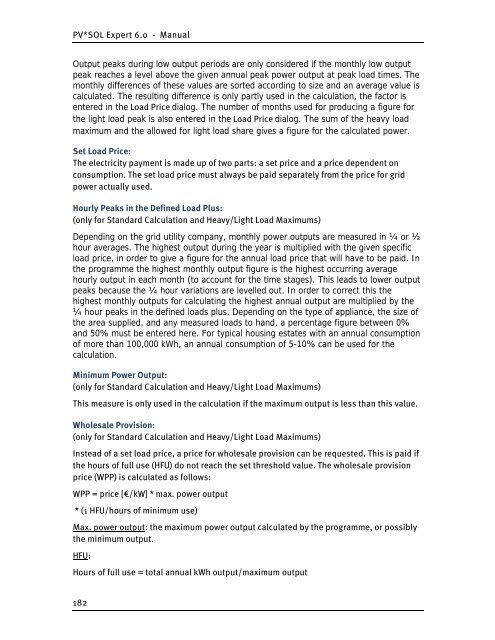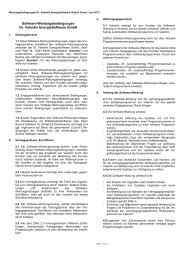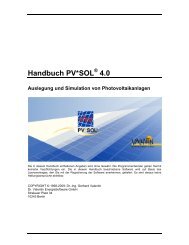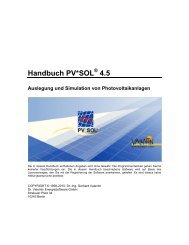PV*SOL Expert 6.0 - Manual - Valentin Software
PV*SOL Expert 6.0 - Manual - Valentin Software
PV*SOL Expert 6.0 - Manual - Valentin Software
You also want an ePaper? Increase the reach of your titles
YUMPU automatically turns print PDFs into web optimized ePapers that Google loves.
<strong>PV*SOL</strong> <strong>Expert</strong> <strong>6.0</strong> - <strong>Manual</strong><br />
Output peaks during low output periods are only considered if the monthly low output<br />
peak reaches a level above the given annual peak power output at peak load times. The<br />
monthly differences of these values are sorted according to size and an average value is<br />
calculated. The resulting difference is only partly used in the calculation, the factor is<br />
entered in the Load Price dialog. The number of months used for producing a figure for<br />
the light load peak is also entered in the Load Price dialog. The sum of the heavy load<br />
maximum and the allowed for light load share gives a figure for the calculated power.<br />
Set Load Price:<br />
The electricity payment is made up of two parts: a set price and a price dependent on<br />
consumption. The set load price must always be paid separately from the price for grid<br />
power actually used.<br />
Hourly Peaks in the Defined Load Plus:<br />
(only for Standard Calculation and Heavy/Light Load Maximums)<br />
Depending on the grid utility company, monthly power outputs are measured in ¼ or ½<br />
hour averages. The highest output during the year is multiplied with the given specific<br />
load price, in order to give a figure for the annual load price that will have to be paid. In<br />
the programme the highest monthly output figure is the highest occurring average<br />
hourly output in each month (to account for the time stages). This leads to lower output<br />
peaks because the ¼ hour variations are levelled out. In order to correct this the<br />
highest monthly outputs for calculating the highest annual output are multiplied by the<br />
¼ hour peaks in the defined loads plus. Depending on the type of appliance, the size of<br />
the area supplied, and any measured loads to hand, a percentage figure between 0%<br />
and 50% must be entered here. For typical housing estates with an annual consumption<br />
of more than 100,000 kWh, an annual consumption of 5-10% can be used for the<br />
calculation.<br />
Minimum Power Output:<br />
(only for Standard Calculation and Heavy/Light Load Maximums)<br />
This measure is only used in the calculation if the maximum output is less than this value.<br />
Wholesale Provision:<br />
(only for Standard Calculation and Heavy/Light Load Maximums)<br />
Instead of a set load price, a price for wholesale provision can be requested. This is paid if<br />
the hours of full use (HFU) do not reach the set threshold value. The wholesale provision<br />
price (WPP) is calculated as follows:<br />
WPP = price [€/kW] * max. power output<br />
* (1 HFU/hours of minimum use)<br />
Max. power output: the maximum power output calculated by the programme, or possibly<br />
the minimum output.<br />
HFU:<br />
Hours of full use = total annual kWh output/maximum output<br />
182
















